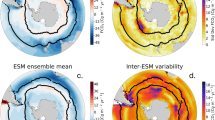Abstract
AN understanding of the natural sources and sinks of atmospheric carbon dioxide is necessary for predictions of future atmospheric loading and its consequences for global climate. Present estimates of emissions and uptake do not balance1, and although some have attributed the imbalance to a terrestrial sink2, the magnitude of the oceanic sink remains unresolved2–4. It is known5–8 that the upper 1 mm or so of the oceans represents a cool 'skin', with a temperature gradient such that the surface is generally cooler than the bulk mixed layer by about 0.3 °C as a result of the upward heat flux. Here we discuss the consequences of the 'skin effect' for the global air–sea flux of CO2. We show that it produces an increased oceanic global uptake of about 0.7 Gt C yr−1, when the flux from the atmosphere to the oceans is calculated on the basis of measured surface-ocean partial pressures of CO2. This correction helps to bring into closer agreement the oceanic CO2 uptake calculated by different methods2–4.
Similar content being viewed by others
References
Houghton, J. T., Jenkins, G. J. & Ephraums, J. J. (eds) Climate Change, The IPCC Scientific Assessment (Cambridge Univ. Press 1990).
Tans, P. P., Fung, I. Y. & Takahashi, T. Science 247, 1431–1438 (1990).
Sarmiento, J. L., Siegenthaler, U. & Orr, J. C.q J. geophys. Res. (in the press).
Sarmiento, J. L. & Sundquist, E. Nature 356, 589–593 (1992).
Hasse, L. Boundary Layer Met 1, 368–379 (1971).
Katsaros, K. B. Tellus 29, 229–239 (1977).
Simpson, J. J. & Paulson, C. A. J. phys. Oceanogr. 10, 399–410 (1980).
Schluessel, P., Emery, W. J., Grasl, H. & Mammen, T. J. geophys. Res 95, 13341–13356 (1990).
Etcheto, J., Boutin, J. & Merlivat, L. Tellus 43B, 247–255 (1991).
Watson, A. J., Robinson, C., Robertson, J. E., Williams, P. J. LeB. & Fasham, M. J. R. Nature 350, 50–53 (1991).
Wong, C. S. & Chan, Y.-H. Tellus 43B, 206–223 (1991).
Brès, B., Brunet, C., Metzl, N., Poisson, A. & Schauer, B. NATO/ASI Abstr. The Global Carbon Cycle, II Cioccio 8–20 September (1991).
Merlivat, L., Etcheto, J. & Boutin, J. Adv. Space Res. 11, 377–385 (1991).
Enting, I. G. & Mansbridge, J. V. Tellus 41B, 111–126 (1989).
Keeling, C. D., Piper, S. & Heimann, M. Am. geophys. Chem Monogr., 55, 305–363 (AGU, Washington DC (1989).
Weiss, R. F. Mar. Chem. 2, 203–215 (1974).
Johnson, K. S. Limnol Oceanogr. 27, 849–855 (1982).
Oberhuber, J. Max Planck Inst für Met. Rep. No 15 (1988).
Wright, P. Max Planck Inst für Met. Rep. 14 (1988).
Enting, I. G. & Mansbridge, J. V. Tellus B43, 156–170 (1991).
Phillips, L. F. Geophys. Res. Lett 18, 1221–1224 (1991).
Author information
Authors and Affiliations
Rights and permissions
About this article
Cite this article
Robertson, J., Watson, A. Thermal skin effect of the surface ocean and its implications for CO2 uptake. Nature 358, 738–740 (1992). https://doi.org/10.1038/358738a0
Received:
Accepted:
Issue Date:
DOI: https://doi.org/10.1038/358738a0
- Springer Nature Limited
This article is cited by
-
Revised estimates of ocean-atmosphere CO2 flux are consistent with ocean carbon inventory
Nature Communications (2020)
-
Interannual variability of carbon dioxide drawdown by subantarctic surface water near New Zealand
Biogeochemistry (2011)
-
Seeking carbon-consistency in the climate-science-to-policy interface
Biogeochemistry (2011)
-
Diurnal sea surface temperature variation and its impact on the atmosphere and ocean: A review
Journal of Oceanography (2007)
-
Oceanic transport and storage of carbon emissions
Climatic Change (1995)





